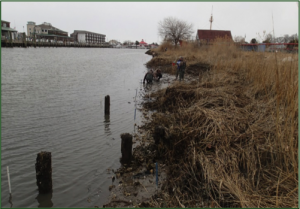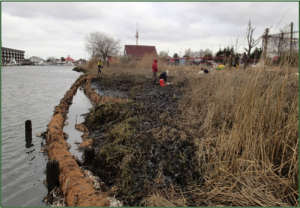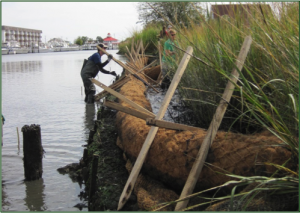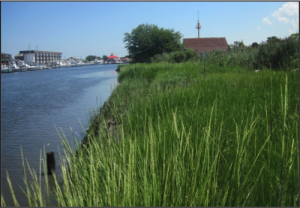
Facebook Twitter Instagram YouTube RSS Feed
Written on: October 23rd, 2015 in Living Shorelines

Lewes, DE eroding shoreline before restoration in winter of 2013
A “Living Shoreline” is a method of bank stabilization that reinforces the shoreline to protect coastal properties from erosion, while also restoring and enhancing fish, wildlife water quality and wetland habitat. Unlike bulkheads and stone riprap, living shorelines use natural materials to maintain existing connections between the shoreline and aquatic areas. A number of living shoreline materials and tactics are available, including coconut fiber coir logs, natural fiber matting, recycled shell, and native wetland vegetation.

Living shoreline installation phase I in the spring of 2014
Living shorelines have been built throughout Delaware’s coastal regions and are a popular option for bank stabilization because they protect property from erosion while attracting fish and shellfish, filtering polluted runoff, and absorbing wave energy during storms.
This restoration site was constructed to address an undercut and deteriorating existing salt marsh shoreline. The site is exposed to low energy for the majority of the time with peaks of energy from boats launching from the opposite shoreline. The site has low energy, so standard vegetated living shoreline tactics were selected. Shorelines subject to high wave energy may require marsh sills or offshore breakwaters but should only be used when necessary.

Living shoreline installation phase II in the fall of 2014
The slope of the eroding shoreline required two tiers of coconut fiber logs staked on top of each other to reach the optimal elevation for Spartina grass. The first round of coconut fiber matting and logs were positioned in the intertidal zone before being staked down and tied in place. Oyster shell bags were then arranged in front of the coir logs to further armor the shoreline and absorb wave energy. The next step was to allow sediment to fall out of the naturally turbid water into the cells created by the coconut fiber logs.

Living shoreline restoration in the summer of 2015
This Living Shoreline project was installed on April 14-17, 2014. After 6 months enough sediment had built up inside the shoreline that the second tier of coconut fiber logs were installed on October 20, 2014. The second tier of logs allowed sediment to continue to accumulate and raise the elevation to the optimal growing elevation for Smooth Cordgrass. The site was planted in March/April 2015 with Smooth Cordgrass. Spring planting allowed vegetation to take root throughout the growing season before winter storms.
Living Shorelines may need augmentation over the years. However, successful projects throughout the Mid-Atlantic have survived multiple hurricanes!
This project was collaboration between Delaware Department of Natural Resources, Partnership for the Delaware Estuary and Delaware Center for the Inland Bays.
Tags: Delaware Center for the Inland Bays, Delaware Department of Natural Resources, Delaware Estuary, Installing a Living Shoreline in Lewes, Lewes Delaware, Wetland Monitoring & Assessment Program